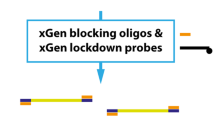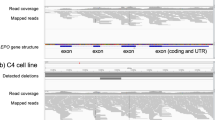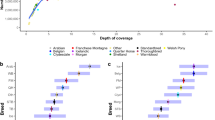Abstract
Throughout the history of horse racing, doping techniques to suppress or enhance performance have expanded to match the technology available. The next frontier in doping, both in the equine and human sports areas, is predicted to be genetic manipulation; either by prohibited use of genome editing, or gene therapy via transgenes. By using massively-parallel sequencing via a two-step PCR method we can screen for multiple doping targets at once in pooled primer sets. This method has the advantages of high scalability through combinational indexing, and the use of reference standards with altered sequences as controls. Custom software produces transgene-specific amplicons from any Ensembl-annotated genome to facilitate rapid assay design. Additional scripts batch-process FASTQ data from experiments, automatically quality-filtering sequences and assigning hits based on discriminatory motifs. We report here our experiences in establishing the workflow with an initial 31 transgene and vector feature targets. To evaluate the sensitivity of parallel sequencing in a real-world setting, we performed an intramuscular (IM) administration of a control rAAV vector into two horses and compared the detection sensitivity between parallel sequencing and real-time qPCR. Vector was detected by all assays on both methods up to 79 h post-administration, becoming sporadic after 96 h.
This is a preview of subscription content, access via your institution
Access options
Subscribe to this journal
Receive 12 print issues and online access
$259.00 per year
only $21.58 per issue
Buy this article
- Purchase on Springer Link
- Instant access to full article PDF
Prices may be subject to local taxes which are calculated during checkout





Similar content being viewed by others
Code availability
Please contact the corresponding author if you wish to access the code used for the design and analysis scripts. Availability is subject to approval from the British Horseracing Authority.
References
Bertoni C, Jarrahian S, Wheeler TM, Li Y, Olivares EC, Calos MP, et al. Enhancement of plasmid-mediated gene therapy for muscular dystrophy by directed plasmid integration. Proc Natl Acad Sci USA. 2006;103:419–24.
Williams PD, Kingston PA. Plasmid-mediated gene therapy for cardiovascular disease. Cardiovasc Res. 2011;91:565–76.
Shimpo M, Ikeda U, Maeda Y, Takahashi M, Miyashita H, Mizukami H, et al. AAV-mediated VEGF gene transfer into skeletal muscle stimulates angiogenesis and improves blood flow in a rat hindlimb ischemia model. Cardiovasc Res. 2002;53:993–1001.
Xiao X, Li J, Samulski RJ, McCullough B, Gao G-P, Wilson JM, et al. Efficient long-term gene transfer into muscle tissue of immunocompetent mice by adeno-associated virus vector. J Virol. 1996;70:8098–108.
Tabebordbar M, Zhu K, Cheng JKW, Chew WL, Widrick JJ, Yan WX, et al. In vivo gene editing in dystrophic mouse muscle and muscle stem cells. Science. 2016;351:407–11.
Kim K, Park SW, Kim JH, Lee SH, Kim D, Koo T, et al. Genome surgery using Cas9 ribonucleoproteins for the treatment of age-related macular degeneration. Genome Res. 2017;27:419–26.
Kovac M, Litvin YA, Aliev RO, Zakirova EY, Rutland CS, Kiyasov AP, et al. Gene therapy using plasmid DNA encoding VEGF164 and FGF2 genes: a novel treatment of naturally occurring tendinitis and desmitis in horses. Front Pharmacol. 2018;9:978.
Watson Levings RS, Broome TA, Smith AD, Rice BL, Gibbs EP, Myara DA, et al. Gene therapy for osteoarthritis: pharmacokinetics of intra-articular self-complementary adeno-associated virus interleukin-1 receptor antagonist delivery in an equine model. Hum Gene Ther Clin Dev. 2018;29:90–100.
Neuhaus CP, Parent B. Gene doping-In animals? Ethical issues at the intersection of animal use, gene editing, and sports ethics. Cambridge Q Healthc Ethics. 2019;28:26–39.
Campbell MLH, McNamee MJ. Ethics, genetic technologies and equine sports: the prospect of regulation of a modified therapeutic use exemption policy. Sport Ethics Philos. 2020;15:1–24.
Baoutina A, Alexander IE, Rasko JEJ, Emslie KR. Developing strategies for detection of gene doping. J Gene Med. 2008;10:3–20.
Brzeziańska E, Domańska D, Jegier A. Gene doping in sport - perspectives and risks. Biol Sport. 2014;31:251–9.
Oliveira RS, Collares TF, Smith KR, Collares TV, Seixas FK. The use of genes for performance enhancement: doping or therapy? Brazilian J Med Biol Res. 2011;44:1194–201.
Garton FC, Houweling PJ, Vukcevic D, Meehan LR, Lee FXZ, Lek M, et al. The effect of ACTN3 gene doping on skeletal muscle performance. Am J Hum Genet. 2018;102:845–57.
Zhou S, Murphy J, Escobedo J, Dwarki V. Adeno-associated virus-mediated delivery of erythropoietin leads to sustained elevation of hematocrit in nonhuman primates. Gene Ther. 1998;5:665–70.
Ni W, Le Guiner C, Gernoux G, Penaud-Budloo M, Moullier P, Snyder RO. Longevity of rAAV vector and plasmid DNA in blood after intramuscular injection in nonhuman primates: implications for gene doping. Gene Ther. 2011;18:709–18.
Kalbfleisch TS, Rice ES, DePriest MS, Walenz BP, Hestand MS, Vermeesch JR, et al. Improved reference genome for the domestic horse increases assembly contiguity and composition. Commun Biol. 2018;1:197.
Yates AD, Achuthan P, Akanni W, Allen J, Allen J, Alvarez-Jarreta J, et al. Ensembl 2020. Nucleic Acids Res. 2019;48:D682–8.
Baoutina A, Coldham T, Bains GS, Emslie KR. Gene doping detection: evaluation of approach for direct detection of gene transfer using erythropoietin as a model system. Gene Ther. 2010;17:1022–32.
Sugasawa T, Aoki K, Yanazawa K, Takekoshi K. Detection of multiple transgene fragments in a mouse model of gene doping based on plasmid vector using TaqMan-qPCR assay. Genes. 2020;11:750.
Tozaki T, Gamo S, Takasu M, Kikuchi M, Kakoi H, Hirota K, et al. Digital PCR detection of plasmid DNA administered to the skeletal muscle of a microminipig: a model case study for gene doping detection. BMC Res Notes. 2018;11:708.
Tozaki T, Ohnuma A, Takasu M, Kikuchi M, Kakoi H, Hirota K, et al. Droplet digital PCR detection of the erythropoietin transgene from horse plasma and urine for gene-doping control. Genes. 2019;10:243.
Tozaki T, Ohnuma A, Kikuchi M, Ishige T, Kakoi H, Hirota K, et al. Microfluidic quantitative PCR detection of 12 transgenes from horse plasma for gene doping control. Genes . 2020;11:457.
de Boer EN, van der Wouden PE, Johansson LF, van Diemen CC, Haisma HJ. A next-generation sequencing method for gene doping detection that distinguishes low levels of plasmid DNA against a background of genomic DNA. Gene Ther. 2019;26:338–46.
Salamin O, Kuuranne T, Saugy M, Leuenberger N. Loop‐mediated isothermal amplification (LAMP) as an alternative to PCR: A rapid on‐site detection of gene doping. Drug Test Anal. 2017;9:1731–7.
Varshney GK, Pei W, LaFave MC, Idol J, Xu L, Gallardo V, et al. High-throughput gene targeting and phenotyping in zebrafish using CRISPR/Cas9. Genome Res. 2015;25:1030–42.
Fadrosh DW, Ma B, Gajer P, Sengamalay N, Ott S, Brotman RM, et al. An improved dual-indexing approach for multiplexed 16S rRNA gene sequencing on the Illumina MiSeq platform. Microbiome. 2014;2:6.
Wang X, Xu Z, Tian Z, Zhang X, Xu D, Li Q, et al. The EF-1α promoter maintains high-level transgene expression from episomal vectors in transfected CHO-K1 cells. J Cell Mol Med. 2017;21:3044–54.
Hitoshi N, Ken-ichi Y, Jun-ichi M. Efficient selection for high-expression transfectants with a novel eukaryotic vector. Gene. 1991;108:193–9.
Baoutina A, Bhat S, Zheng M, Partis L, Dobeson M, Alexander IE, et al. Synthetic certified DNA reference material for analysis of human erythropoietin transgene and transcript in gene doping and gene therapy. Gene Ther. 2016;23:708–17.
Bruntraeger M, Byrne M, Long K, Bassett AR. Editing the genome of human induced pluripotent stem cells using CRISPR/Cas9 ribonucleoprotein complexes. Methods Mol. Biol. 2019;1961:153–83.
Gleeson D, Sethi D, Platte R, Burvill J, Barrett D, Akhtar S, et al. High-throughput genotyping of high-homology mutant mouse strains by next-generation sequencing. Methods. 2020. https://doi.org/10.1016/j.ymeth.2020.10.011.
Lowe N, Rees JS, Roote J, Ryder E, Armean IM, Johnson G, et al. Analysis of the expression patterns, subcellular localisations and interaction partners of Drosophila proteins using a pigP protein trap library. Development. 2014;141:3994–4005.
Seita Y, Tsukiyama T, Iwatani C, Tsuchiya H, Matsushita J, Azami T, et al. Generation of transgenic cynomolgus monkeys that express green fluorescent protein throughout the whole body. Sci Rep. 2016;6:24868.
György B, Meijer EJ, Ivanchenko MV, Tenneson K, Emond F, Hanlon KS, et al. Gene transfer with AAV9-PHP.B rescues hearing in a mouse model of usher syndrome 3A and transduces hair cells in a non-human primate. Mol Ther Methods Clin Dev. 2019;13:1–13.
Bey K, Ciron C, Dubreil L, Deniaud J, Ledevin M, Cristini J, et al. Efficient CNS targeting in adult mice by intrathecal infusion of single-stranded AAV9-GFP for gene therapy of neurological disorders. Gene Ther. 2017;24:325–32.
Winbanks CE, Murphy KT, Bernardo BC, Qian H, Liu Y, Sepulveda PV, et al. Smad7 gene delivery prevents muscle wasting associated with cancer cachexia in mice. Sci Transl Med. 2016;8:348ra98.
Blankinship MJ, Gregorevic P, Allen JM, Harper SQ, Harper H, Halbert CL, et al. Efficient transduction of skeletal muscle using vectors based on adeno-associated virus serotype 6. Mol Ther. 2004;10:671–8.
Ghosh A, Yue Y, Duan D. Viral serotype and the transgene sequence influence overlapping adeno-associated viral (AAV) vector-mediated gene transfer in skeletal muscle. J Gene Med. 2006;8:298.
Gregorevic P, Blankinship MJ, Allen JM, Crawford RW, Meuse L, Miller DG, et al. Systemic delivery of genes to striated muscles using adeno-associated viral vectors. Nat Med. 2004;10:828–34.
Jiang H, Lillicrap D, Patarroyo-White S, Liu T, Qian X, Scallan CD, et al. Multiyear therapeutic benefit of AAV serotypes 2, 6, and 8 delivering factor VIII to hemophilia A mice and dogs. Blood. 2006;108:107–15.
Stone D, Liu Y, Li Z-Y, Strauss R, Finn EE, Allen JM, et al. Biodistribution and safety profile of recombinant adeno-associated virus serotype 6 vectors following intravenous delivery. J Virol. 2008;82:7711–5.
Ahmetov II, Egorova ES, Gabdrakhmanova LJ, Fedotovskaya ON. Genes and athletic performance: an update. Med Sport Sci. 2016;61:41–54.
Schröder W, Klostermann A, Distl O. Candidate genes for physical performance in the horse. Vet J. 2011;190:39–48.
Wilkin T, Baoutina A, Hamilton N. Equine performance genes and the future of doping in horseracing. Drug Test Anal. 2017;9:1456–71.
Gu J, Mac Hugh DE, McGivney BA, Park SDE, Katz LM, Hill EW. Association of sequence variants in CKM (creatine kinase, muscle) and COX4I2 (cytochrome c oxidase, subunit 4, isoform 2) genes with racing performance in Thoroughbred horses. Equine Vet J. 2010;42:569–75.
Gao Z, Herrera-Carrillo E, Berkhout B. A single H1 promoter can drive both guide RNA and endonuclease expression in the CRISPR-Cas9 system. Mol Ther Nucleic Acids. 2019;14:32–40.
Untergasser A, Cutcutache I, Koressaar T, Ye J, Faircloth BC, Remm M, et al. Primer3—new capabilities and interfaces. Nucleic Acids Res. 2012;40:e115–e115.
O’Leary NA, Wright MW, Brister JR, Ciufo S, Haddad D, McVeigh R, et al. Reference sequence (RefSeq) database at NCBI: current status, taxonomic expansion, and functional annotation. Nucleic Acids Res. 2016;44:D733–D745.
Quail MA, Swerdlow H, Turner DJ, Swerdlow H. Improved protocols for the illumina genome analyzer sequencing system. Curr Protoc Hum Genet. 2009;62:18.2.1–18.2.27
Taylor SC, Nadeau K, Abbasi M, Lachance C, Nguyen M, Fenrich J. The ultimate qPCR experiment: producing publication quality, reproducible data the first time. Trends Biotechnol. 2019;37:761–74.
Tenover FC, Huang MB, Rasheed JK, Persing DH. Development of PCR assays to detect ampicillin resistance genes in cerebrospinal fluid samples containing Haemophilus influenzae. J Clin Microbiol. 1994;32:2729–37.
Langmead B, Salzberg SL. Fast gapped-read alignment with Bowtie 2. Nat Methods. 2012;9:357–9.
Robinson JT, Thorvaldsdóttir H, Winckler W, Guttman M, Lander ES, Getz G, et al. Integrative genomics viewer. Nat Biotechnol. 2011;29:24–26.
Wingo TS, Kotlar A, Cutler DJ. MPD: multiplex primer design for next-generation targeted sequencing. BMC Bioinformatics. 2017;18:14.
Ponti G, Maccaferri M, Manfredini M, Kaleci S, Mandrioli M, Pellacani G, et al. The value of fluorimetry (Qubit) and spectrophotometry (NanoDrop) in the quantification of cell-free DNA (cfDNA) in malignant melanoma and prostate cancer patients. Clin Chim Acta. 2018;479:14–19.
Sanders R, Huggett JF, Bushell CA, Cowen S, Scott DJ, Foy CA. Evaluation of digital PCR for absolute DNA quantification. Anal Chem. 2011;83:6474–84.
Calcedo R, Franco J, Qin Q, Richardson DW, Mason JB, Boyd S, et al. Preexisting neutralizing antibodies to adeno-associated virus capsids in large animals other than monkeys may confound in vivo gene therapy studies. Hum Gene Ther Methods. 2015;26:103–5.
Haughan J, Jiang Z, Stefanovski D, Moss KL, Ortved KF, Robinson MA. Detection of intra-articular gene therapy in horses using quantitative real time PCR in synovial fluid and plasma. Drug Test Anal. 2020;12:743–51.
Thieme D, Grosse J, Lang R, Mueller R, Wahl A. Screening, confirmation and quantitation of diuretics in urine for doping control analysis by high-performance liquid chromatography–atmospheric pressure ionisation tandem mass spectrometry. J Chromatogr B Biomed Sci Appl. 2001;757:49–57.
Acknowledgements
The British Horseracing Authority (BHA) for funding the analytical work carried out for this study and conducting the animal administrations of the rAAV vector. Staff and students at the Centre for Racehorse Studies (CRS), UK, are also acknowledged for their care and sampling of the horses involved in this work.
Funding
This work was funded by the British Horseracing Authority (BHA).
Author information
Authors and Affiliations
Corresponding author
Ethics declarations
Competing interests
The authors declare no competing interests.
Additional information
Publisher’s note Springer Nature remains neutral with regard to jurisdictional claims in published maps and institutional affiliations.
Supplementary information
Rights and permissions
About this article
Cite this article
Maniego, J., Pesko, B., Habershon-Butcher, J. et al. Screening for gene doping transgenes in horses via the use of massively parallel sequencing. Gene Ther 29, 236–246 (2022). https://doi.org/10.1038/s41434-021-00279-1
Received:
Revised:
Accepted:
Published:
Issue Date:
DOI: https://doi.org/10.1038/s41434-021-00279-1



